Xuanyang Zhang
ViStoryBench: Comprehensive Benchmark Suite for Story Visualization
May 30, 2025Abstract:Story visualization, which aims to generate a sequence of visually coherent images aligning with a given narrative and reference images, has seen significant progress with recent advancements in generative models. To further enhance the performance of story visualization frameworks in real-world scenarios, we introduce a comprehensive evaluation benchmark, ViStoryBench. We collect a diverse dataset encompassing various story types and artistic styles, ensuring models are evaluated across multiple dimensions such as different plots (e.g., comedy, horror) and visual aesthetics (e.g., anime, 3D renderings). ViStoryBench is carefully curated to balance narrative structures and visual elements, featuring stories with single and multiple protagonists to test models' ability to maintain character consistency. Additionally, it includes complex plots and intricate world-building to challenge models in generating accurate visuals. To ensure comprehensive comparisons, our benchmark incorporates a wide range of evaluation metrics assessing critical aspects. This structured and multifaceted framework enables researchers to thoroughly identify both the strengths and weaknesses of different models, fostering targeted improvements.
Step1X-3D: Towards High-Fidelity and Controllable Generation of Textured 3D Assets
May 12, 2025Abstract:While generative artificial intelligence has advanced significantly across text, image, audio, and video domains, 3D generation remains comparatively underdeveloped due to fundamental challenges such as data scarcity, algorithmic limitations, and ecosystem fragmentation. To this end, we present Step1X-3D, an open framework addressing these challenges through: (1) a rigorous data curation pipeline processing >5M assets to create a 2M high-quality dataset with standardized geometric and textural properties; (2) a two-stage 3D-native architecture combining a hybrid VAE-DiT geometry generator with an diffusion-based texture synthesis module; and (3) the full open-source release of models, training code, and adaptation modules. For geometry generation, the hybrid VAE-DiT component produces TSDF representations by employing perceiver-based latent encoding with sharp edge sampling for detail preservation. The diffusion-based texture synthesis module then ensures cross-view consistency through geometric conditioning and latent-space synchronization. Benchmark results demonstrate state-of-the-art performance that exceeds existing open-source methods, while also achieving competitive quality with proprietary solutions. Notably, the framework uniquely bridges the 2D and 3D generation paradigms by supporting direct transfer of 2D control techniques~(e.g., LoRA) to 3D synthesis. By simultaneously advancing data quality, algorithmic fidelity, and reproducibility, Step1X-3D aims to establish new standards for open research in controllable 3D asset generation.
StyleMe3D: Stylization with Disentangled Priors by Multiple Encoders on 3D Gaussians
Apr 21, 2025Abstract:3D Gaussian Splatting (3DGS) excels in photorealistic scene reconstruction but struggles with stylized scenarios (e.g., cartoons, games) due to fragmented textures, semantic misalignment, and limited adaptability to abstract aesthetics. We propose StyleMe3D, a holistic framework for 3D GS style transfer that integrates multi-modal style conditioning, multi-level semantic alignment, and perceptual quality enhancement. Our key insights include: (1) optimizing only RGB attributes preserves geometric integrity during stylization; (2) disentangling low-, medium-, and high-level semantics is critical for coherent style transfer; (3) scalability across isolated objects and complex scenes is essential for practical deployment. StyleMe3D introduces four novel components: Dynamic Style Score Distillation (DSSD), leveraging Stable Diffusion's latent space for semantic alignment; Contrastive Style Descriptor (CSD) for localized, content-aware texture transfer; Simultaneously Optimized Scale (SOS) to decouple style details and structural coherence; and 3D Gaussian Quality Assessment (3DG-QA), a differentiable aesthetic prior trained on human-rated data to suppress artifacts and enhance visual harmony. Evaluated on NeRF synthetic dataset (objects) and tandt db (scenes) datasets, StyleMe3D outperforms state-of-the-art methods in preserving geometric details (e.g., carvings on sculptures) and ensuring stylistic consistency across scenes (e.g., coherent lighting in landscapes), while maintaining real-time rendering. This work bridges photorealistic 3D GS and artistic stylization, unlocking applications in gaming, virtual worlds, and digital art.
InstructLayout: Instruction-Driven 2D and 3D Layout Synthesis with Semantic Graph Prior
Jul 11, 2024Abstract:Comprehending natural language instructions is a charming property for both 2D and 3D layout synthesis systems. Existing methods implicitly model object joint distributions and express object relations, hindering generation's controllability. We introduce InstructLayout, a novel generative framework that integrates a semantic graph prior and a layout decoder to improve controllability and fidelity for 2D and 3D layout synthesis. The proposed semantic graph prior learns layout appearances and object distributions simultaneously, demonstrating versatility across various downstream tasks in a zero-shot manner. To facilitate the benchmarking for text-driven 2D and 3D scene synthesis, we respectively curate two high-quality datasets of layout-instruction pairs from public Internet resources with large language and multimodal models. Extensive experimental results reveal that the proposed method outperforms existing state-of-the-art approaches by a large margin in both 2D and 3D layout synthesis tasks. Thorough ablation studies confirm the efficacy of crucial design components.
4K4DGen: Panoramic 4D Generation at 4K Resolution
Jun 19, 2024
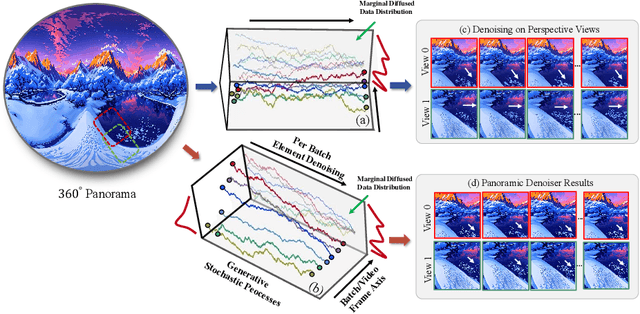

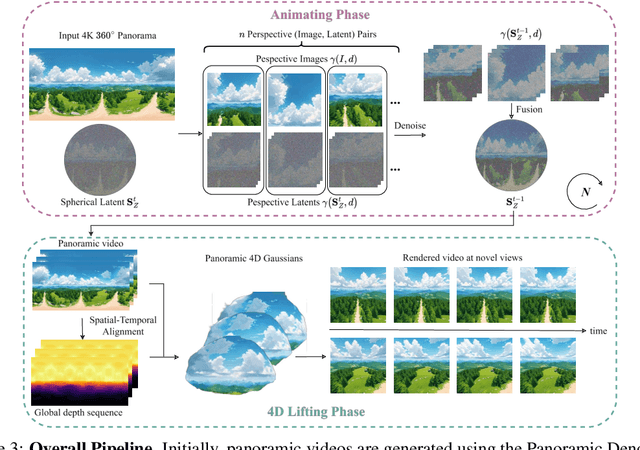
Abstract:The blooming of virtual reality and augmented reality (VR/AR) technologies has driven an increasing demand for the creation of high-quality, immersive, and dynamic environments. However, existing generative techniques either focus solely on dynamic objects or perform outpainting from a single perspective image, failing to meet the needs of VR/AR applications. In this work, we tackle the challenging task of elevating a single panorama to an immersive 4D experience. For the first time, we demonstrate the capability to generate omnidirectional dynamic scenes with 360-degree views at 4K resolution, thereby providing an immersive user experience. Our method introduces a pipeline that facilitates natural scene animations and optimizes a set of 4D Gaussians using efficient splatting techniques for real-time exploration. To overcome the lack of scene-scale annotated 4D data and models, especially in panoramic formats, we propose a novel Panoramic Denoiser that adapts generic 2D diffusion priors to animate consistently in 360-degree images, transforming them into panoramic videos with dynamic scenes at targeted regions. Subsequently, we elevate the panoramic video into a 4D immersive environment while preserving spatial and temporal consistency. By transferring prior knowledge from 2D models in the perspective domain to the panoramic domain and the 4D lifting with spatial appearance and geometry regularization, we achieve high-quality Panorama-to-4D generation at a resolution of (4096 $\times$ 2048) for the first time. See the project website at https://4k4dgen.github.io.
Benchmarks and Challenges in Pose Estimation for Egocentric Hand Interactions with Objects
Mar 25, 2024
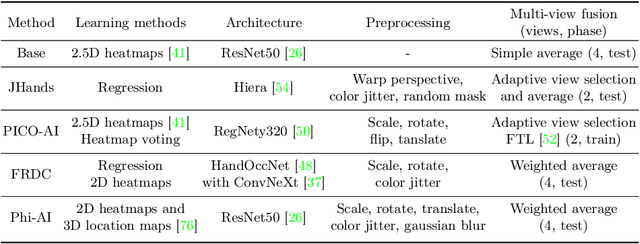

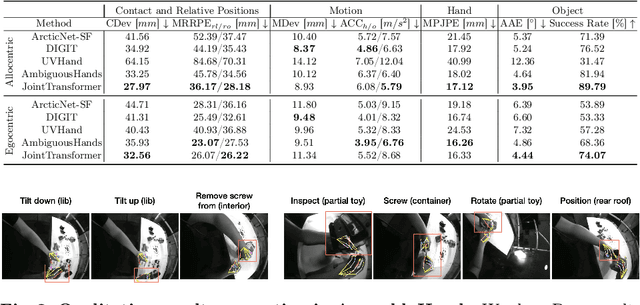
Abstract:We interact with the world with our hands and see it through our own (egocentric) perspective. A holistic 3D understanding of such interactions from egocentric views is important for tasks in robotics, AR/VR, action recognition and motion generation. Accurately reconstructing such interactions in 3D is challenging due to heavy occlusion, viewpoint bias, camera distortion, and motion blur from the head movement. To this end, we designed the HANDS23 challenge based on the AssemblyHands and ARCTIC datasets with carefully designed training and testing splits. Based on the results of the top submitted methods and more recent baselines on the leaderboards, we perform a thorough analysis on 3D hand(-object) reconstruction tasks. Our analysis demonstrates the effectiveness of addressing distortion specific to egocentric cameras, adopting high-capacity transformers to learn complex hand-object interactions, and fusing predictions from different views. Our study further reveals challenging scenarios intractable with state-of-the-art methods, such as fast hand motion, object reconstruction from narrow egocentric views, and close contact between two hands and objects. Our efforts will enrich the community's knowledge foundation and facilitate future hand studies on egocentric hand-object interactions.
OpenSUN3D: 1st Workshop Challenge on Open-Vocabulary 3D Scene Understanding
Feb 23, 2024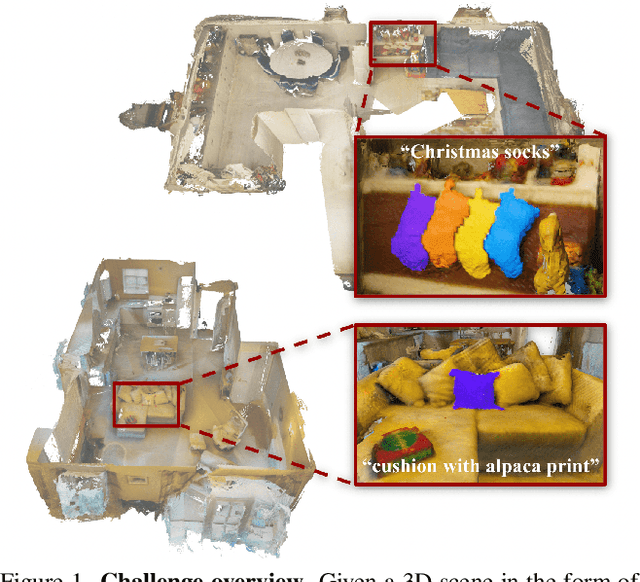
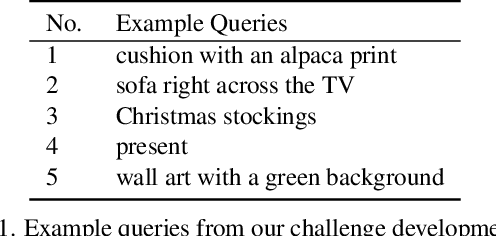

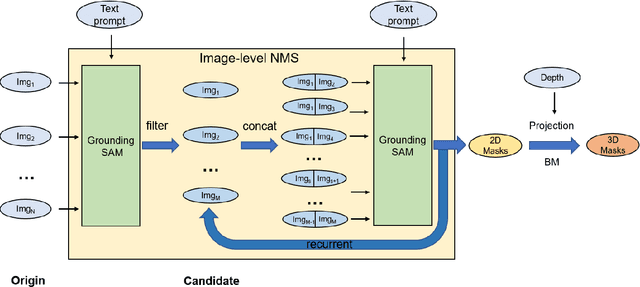
Abstract:This report provides an overview of the challenge hosted at the OpenSUN3D Workshop on Open-Vocabulary 3D Scene Understanding held in conjunction with ICCV 2023. The goal of this workshop series is to provide a platform for exploration and discussion of open-vocabulary 3D scene understanding tasks, including but not limited to segmentation, detection and mapping. We provide an overview of the challenge hosted at the workshop, present the challenge dataset, the evaluation methodology, and brief descriptions of the winning methods. For additional details, please see https://opensun3d.github.io/index_iccv23.html.
Differentiable Architecture Search with Random Features
Aug 18, 2022
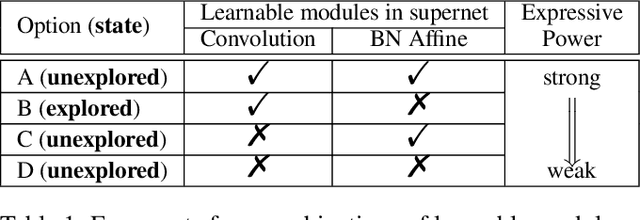
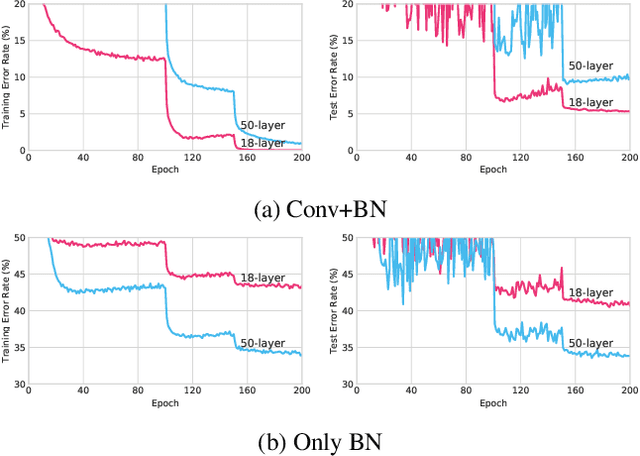
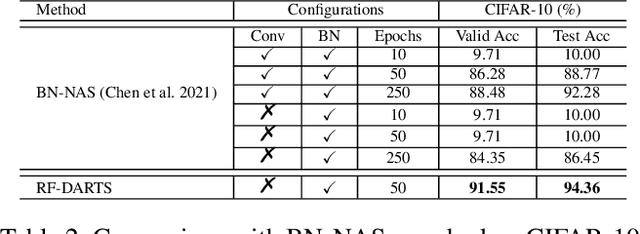
Abstract:Differentiable architecture search (DARTS) has significantly promoted the development of NAS techniques because of its high search efficiency and effectiveness but suffers from performance collapse. In this paper, we make efforts to alleviate the performance collapse problem for DARTS from two aspects. First, we investigate the expressive power of the supernet in DARTS and then derive a new setup of DARTS paradigm with only training BatchNorm. Second, we theoretically find that random features dilute the auxiliary connection role of skip-connection in supernet optimization and enable search algorithm focus on fairer operation selection, thereby solving the performance collapse problem. We instantiate DARTS and PC-DARTS with random features to build an improved version for each named RF-DARTS and RF-PCDARTS respectively. Experimental results show that RF-DARTS obtains \textbf{94.36\%} test accuracy on CIFAR-10 (which is the nearest optimal result in NAS-Bench-201), and achieves the newest state-of-the-art top-1 test error of \textbf{24.0\%} on ImageNet when transferring from CIFAR-10. Moreover, RF-DARTS performs robustly across three datasets (CIFAR-10, CIFAR-100, and SVHN) and four search spaces (S1-S4). Besides, RF-PCDARTS achieves even better results on ImageNet, that is, \textbf{23.9\%} top-1 and \textbf{7.1\%} top-5 test error, surpassing representative methods like single-path, training-free, and partial-channel paradigms directly searched on ImageNet.
When NAS Meets Trees: An Efficient Algorithm for Neural Architecture Search
Apr 11, 2022



Abstract:The key challenge in neural architecture search (NAS) is designing how to explore wisely in the huge search space. We propose a new NAS method called TNAS (NAS with trees), which improves search efficiency by exploring only a small number of architectures while also achieving a higher search accuracy. TNAS introduces an architecture tree and a binary operation tree, to factorize the search space and substantially reduce the exploration size. TNAS performs a modified bi-level Breadth-First Search in the proposed trees to discover a high-performance architecture. Impressively, TNAS finds the global optimal architecture on CIFAR-10 with test accuracy of 94.37\% in four GPU hours in NAS-Bench-201. The average test accuracy is 94.35\%, which outperforms the state-of-the-art. Code is available at: \url{https://github.com/guochengqian/TNAS}.
Partial to Whole Knowledge Distillation: Progressive Distilling Decomposed Knowledge Boosts Student Better
Sep 26, 2021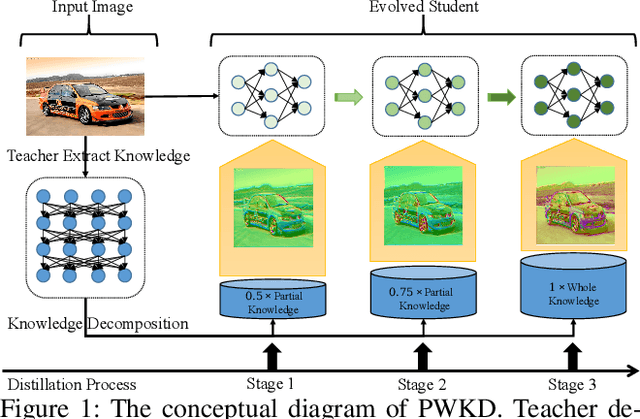



Abstract:Knowledge distillation field delicately designs various types of knowledge to shrink the performance gap between compact student and large-scale teacher. These existing distillation approaches simply focus on the improvement of \textit{knowledge quality}, but ignore the significant influence of \textit{knowledge quantity} on the distillation procedure. Opposed to the conventional distillation approaches, which extract knowledge from a fixed teacher computation graph, this paper explores a non-negligible research direction from a novel perspective of \textit{knowledge quantity} to further improve the efficacy of knowledge distillation. We introduce a new concept of knowledge decomposition, and further put forward the \textbf{P}artial to \textbf{W}hole \textbf{K}nowledge \textbf{D}istillation~(\textbf{PWKD}) paradigm. Specifically, we reconstruct teacher into weight-sharing sub-networks with same depth but increasing channel width, and train sub-networks jointly to obtain decomposed knowledge~(sub-networks with more channels represent more knowledge). Then, student extract partial to whole knowledge from the pre-trained teacher within multiple training stages where cyclic learning rate is leveraged to accelerate convergence. Generally, \textbf{PWKD} can be regarded as a plugin to be compatible with existing offline knowledge distillation approaches. To verify the effectiveness of \textbf{PWKD}, we conduct experiments on two benchmark datasets:~CIFAR-100 and ImageNet, and comprehensive evaluation results reveal that \textbf{PWKD} consistently improve existing knowledge distillation approaches without bells and whistles.
 Add to Chrome
Add to Chrome Add to Firefox
Add to Firefox Add to Edge
Add to Edge